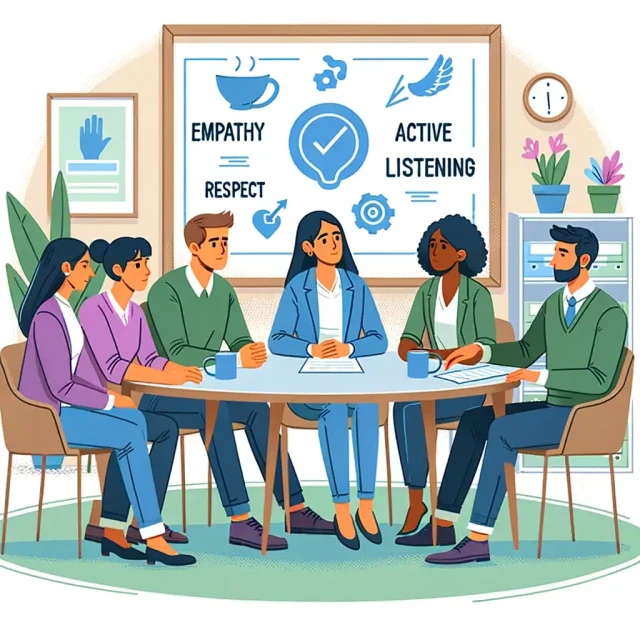Conflict is a very unmissable aspect of human interactions emotionally, deeply rooted in our daily lives, whether in the workplace, personal relationships, or broader societal contexts. Its presence, often viewed negatively, is important for growth and understanding. Effective conflict resolution can increase productivity, improve team dynamics, and create a healthy work environment. In personal relationships, overcoming conflicts skillfully can strengthen bonds and deepen the understanding among individuals.
The purpose of this blog is to demystify the often stressful concept of conflict resolution. Here, we aim to provide comprehensive and practical conflict resolution strategies, not just theoretical knowledge, to empower you in resolving conflicts effectively. Whether you are a business owner or a manager trying to mediate a team dispute, a partner in a relationship seeking harmony, or someone aspiring to improve their interpersonal skills, join us as we explore the point of view of the art of turning Conflict into a stepping stone for constructive change and personal growth.
What are the Various types of Conflict?

Conflict arises when interests, values, actions, communication and collaboration or directions clash.
It manifests in various forms:
- Interpersonal Conflict occurs between individuals.
- Transpersonal conflict happens with an individual involving internal struggle.
- Organisational Conflict arises within groups or convictions.
What are the common causes of Conflict?
The Common causes of Conflict are communication, differing values, and limited resources.
Conflicts can lead to reduced cooperation, deteriorated relationships, and lowered morale when unresolved.
It's essential to recognise that while Conflict is challenging, it also creates opportunities for growth and understanding, making its resolution a crucial skill in personal and professional life.
Fundamental Principles for Resolving Conflicts
(a) High-level conflict resolution is essential in both personal and professional environments. At its core, effective conflict resolution actively revolves around empathy, active listening, and non-confronting communication.
These principles serve as the bedrock for understanding and resolving disagreements healthily.
(b) Empathy plays a pivotal role. It involves putting oneself in another's shoes and understanding their perspective and feelings. This emotional insight fosters a deeper connection and mutual respect, which is essential for resolving conflicts.
Combined with empathy, active listening is also essential. This process requires patience, an open mind, and the willingness to clarify asked questions.
(c) Non-confrontational communication, on the other hand, focuses on expressing one's thoughts and feelings without causing defensiveness or aggression in others.
It's about being assertive yet respectful, ensuring your point is made without escalating and avoiding Conflict.
Mastering conflict principles resolves conflicts more effectively and strengthens relationships, creating a harmonious and productive environment for everyone involved.
Why Emotional Intelligence is Important in Conflict Resolution
When we interact with others, it's essential to be aware of our emotions and the emotions of those around us. This is called emotional intelligence.
We can handle conflicts and difficult situations calmly and clearly when we have high emotional intelligence.
It helps us communicate with empathy and sensitivity, which is important for building positive relationships.

Step-by-Step Guide to Conflict Resolution
Dealing with conflicts is very common in human relationships.
Different opinions and interests can lead to disputes in the workplace, at home, or in various social settings.
Effectively resolving conflicts can lead to better understanding and stronger relationships.
This guide provides a step-by-step approach to going through and resolving conflicts effectively.
Step 1: Identifying the Issue
To resolve any conflict, it's essential to identify the problem accurately without making assumptions or generalisations. This can be achieved through a transparent and truthful conversation where all parties involved express their concerns.
The ultimate objective is to understand the underlying cause of the Conflict, which is more profound than the visible issue on the surface.
For instance, disagreements about project deadlines can lead to miscommunication or unrealistic workload distribution.
Step 2: Understanding Each Party's Perspective
Conflict resolution isn't about finding a solution but also about understanding the different perspectives involved.
Each party has their own set of beliefs, experiences, and emotions that influence their viewpoint. In this step, encourage every person to share their thoughts and feelings about the issue.
Active listening is critical here- listening to understand, not respond. By acknowledging each other's perspectives, parties can begin empathising, essential to finding a resolution.
Step 3: Finding Common Ground
When people disagree, finding things they can agree on is often possible. This is where identifying shared interests or goals can be helpful.
For example, if a family is arguing about where to go on vacation, they might all agree that they want to have a good time and relax.
Acknowledging these shared objectives makes it easier to work together and find a solution that everyone can be happy with.
Step 4: Brainstorming Solutions Together
Once the issue is clearly understood and common ground is established, brainstorming the right solutions is the next step.
This should be a collaborative and creative process where all parties contribute ideas. The key is thinking outside the box and considering various options, even those that might seem impossible initially.
Maintaining a non-judgmental environment where everyone feels comfortable sharing their thoughts is vital.
Step 5: Agreeing on a Solution and Implementing It
After exploring different solutions, the next step is to agree on a course of action. This often involves discussing the pros and cons of each option and deciding on the best that addresses the issue while being acceptable to all parties.
Once a solution has been accepted, it's crucial to outline a plan for its implementation, including what needs to be done, who is responsible for what, and what timelines need to be set up for completion.
Step 6: Follow-up and Evaluation
After resolving a conflict, checking if the solution worked as intended is essential. Depending on the seriousness of the conflict, this can be done a few days, weeks, or months later.
During this check, you should discuss whether the solution helped to solve the problem and if everyone involved is happy with the outcome. If the solution doesn't work, you may need to return to the earlier steps and try something different.
Conflict Resolution in the Workplace: Key Strategies and Leadership Roles

Understanding the Root Causes:
Identifying the root causes of conflicts, such as personality clashes, miscommunication, or competition for resources, is essential.
Proactive measures, such as regular team-building exercises and open communication forums, can help prevent potential conflicts.
Effective Communication Techniques:
It's vital that everyone involved in a conversation listens carefully and makes an effort to understand what's being said.
One way to do this is by repeating what you've heard to ensure you understand correctly.
Also, creating a comfortable environment where employees feel free to share their opinions or concerns without worrying about getting in trouble is crucial.
Role of Leadership:
Managers can set an example of conflict resolution by projecting impartiality and empathy. Conflict management training can equip them with an effective mediation mindset.
Creating a Collaborative Environment:
They are implementing strategies like problem-solving meetings, where team members collaboratively seek solutions rather than placing blame.
How RosterElf helps in conflict resolution effectively in the Workplace

1. Effective Staff Scheduling: RosterElf allows for efficient scheduling that considers employee preferences and availability. This approach minimises scheduling conflicts, reducing tensions related to overwork or unfavourable shifts.
2. Transparent Communication Platform: The software provides a clear channel for communication between managers and staff. This transparency in scheduling and shift changes helps prevent misunderstandings and miscommunications, familiar sources of workplace conflict.
3. Employee Empowerment: RosterElf empowers employees by giving them control over their schedules. They can swap shifts and submit availability, fostering a sense of autonomy and respect, which can significantly reduce interpersonal conflicts.
4. Fair Workload Distribution: The software ensures fair shifts and work hours distribution. This fairness is crucial in preventing conflicts arising from perceived workload and shift assignment inequalities.
Knowing how to deal with conflicts, whether at work or in personal life, is essential. We can learn practical strategies to help turn conflicts into opportunities to grow and strengthen our relationships.
Leaders have an important role in setting an example and creating an environment where people can listen to each other, show empathy, and communicate respectfully.
We can create a more collaborative and dynamic community if we embrace these principles. This means resolving disputes in a way that respects everyone's views and builds a foundation for trust and respect.



